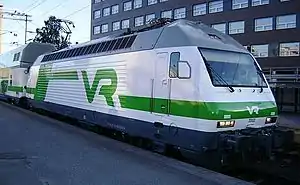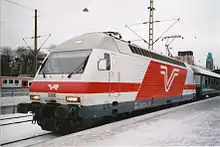VR Class Sr2
The Sr2 is a class of electric locomotives of the VR Group. They were built by SLM/ABB and later by Adtranz and finally Bombardier Transportation and assembled by Transtech Oy.[1][2] They are closely based on the class Re 460 (or Lok 2000) locomotives of Swiss Federal Railways.
| VR class Sr2 | |||||||||||||||||||||||
|---|---|---|---|---|---|---|---|---|---|---|---|---|---|---|---|---|---|---|---|---|---|---|---|
 A Sr2 locomotive at Tampere railway station, June 2012 | |||||||||||||||||||||||
| |||||||||||||||||||||||
| |||||||||||||||||||||||
| |||||||||||||||||||||||
| |||||||||||||||||||||||
The nicknames of this class are Alppiruusu (Edelweiss), Käkikello (Cuckoo clock), both referring to the Swiss origin of the locomotive,[3] as well as Marsu (Guinea pig) and Möhkö (Blob), both from the looks of the locomotive.
History

In 1992, VR ordered the first 20 class Sr2 locomotives;[1] later 20 more were ordered with 12 options. Finally only six of the 12 options were transformed into orders, forming a total fleet of 46 engines.[3] The locomotives are used on both passenger trains and freight trains, and they are the primary locomotives of the fast InterCity trains in Finland.
Until mid-2010s Sr2s were pulling IC trains the classic way, but after Edo-class cab control cars were introduced in 2013,[4] Sr2 units have been used in pull-push mode with IC double deck stock. Until introduction of new Sr3 locomotives, Sr2 has been the only electric locomotive equipped for push-pull among Finnish rolling stock.
Technical information
When introduced, the Sr2 was the fastest and most powerful locomotive of the VR. It was designed with a top speed of 230 km/h (140 mph)[1] and early units had that speed marked on them.[5][6] During test runs, it has achieved a speed of 232 km/h (144 mph). However, VR later limited the top speed to 210 km/h (130 mph),[3] since test runs require 10% faster speed than the targeted commercial speed.
The locomotive has GTO-thyristor inverters driving three-phase asynchronous AC motors.[7] The maximum power of each air-cooled motor is 1,560 kW (2,090 hp) at 2,600 V.[7] Combined, they are capable of a power output of 6,100 kilowatts (8,200 hp) (5,000 kW (6,700 hp) continuous power).[8] The motors are small and fit entirely within the bogies.[7] The bogies weigh only 15.8 tonnes and are equipped with radially steered axles.[1] This reduces rail wear significantly. A redesigned bogie construction was refitted by the manufacturer in the mid-2000s after the locomotives were found to oscillate sideways when running at speeds of over 160 km/h (99 mph).[9]
The whole construction of the locomotive is modular and all functions are controlled by several microprocessors via the locomotive bus (MICAS S2).[7] The system is redundant, so that a failure in one processor does not harm the overall system.[7] The data lines are fiber optic cables.[7]
Sr2 units are fitted with Unilink couplers, which combine a SA3 and a traditional chain coupler.[10]
Design and livery

As with all the Lok 2000 locomotives, the external design is by Pininfarina.[7] The series were painted red and white, showcasing VR's InterCity colours, with a large V on the bodyside to symbolise VR's high-speed traffic.[1][11][12] Starting from number 3222 the V was replaced with VR's logo.[3] Beginning from 2010 and starting from engine number 3221, all units were repainted with VR's current colour scheme (green and white).[2][13]
See also
References
- Eonsuu, Honkanen & Pölhö 1995.
- "Sr2 kalustolista" (in Finnish). Sivuraide.net. Retrieved 2 July 2011.
- "Sr2" (in Finnish). Seisake.net. Retrieved 2 July 2011.
- Ristniemi, Kurt (16 April 2013). "New Edo class steering car being presented to VR personnel" (in Finnish). Vaunut.org. Retrieved 15 September 2016.
- Polamo, Mika (13 May 1996). "Sr2:n virallinen käyttöönotto, esittelytilaisuus" (in Finnish). Vaunut.org. Retrieved 2 July 2011.
- Nyman, Mikko (1996). "Vielä 10 vuotta sitten Sr2:sten kyljissä luki 230 Km/h, ..." (in Finnish). Vaunut.org. Retrieved 10 July 2011.
- Virtanen, Teemu; Grönblom, Aki (February 1999). "Veturi 2000 meillä ja muualla". Resiina (in Finnish). Museorautatieyhdistys ry, Suomen Rautatiehistoriallinen Seura ry: 4–16. ISSN 0356-0600.
- Virtanen, Teemu. "Sr2" (in Finnish). Retrieved 2 July 2011.
- "Sr2-veturin telien muutos" (PDF). Rautatietekniikka. Rautatiealan Teknisten Liitto RTL ry (2): 24. 2006. ISSN 1237-1513.
- Hietaranta, Juhana (2004). "Kytkimet: SA-3 ja Unilink" (in Finnish). Seisake.net. Retrieved 29 July 2011.
- Tölkkö, Juha (29 May 1998). "Sr2 3203 Turkuun P133:ssa" (in Finnish). Vaunut.org. Retrieved 2 July 2011.
- Haaramo, Jukka (25 December 2003). "Valtionrautateiden liikemerkin kehitys" (in Finnish). Archived from the original on 22 February 2007. Retrieved 24 July 2011.
- Vähäkoski, Sauli (19 December 2010). "Vihreä Sr2 3221" (in Finnish). Vaunut.org. Retrieved 2 July 2011.
Literature
- Eonsuu, Tapio; Honkanen, Pekka; Pölhö, Eljas (1995). Suomen veturit osa 2. Moottorikalusto. Elokuvan Maailma. p. 91. ISBN 952-5060-02-0.
External links
![]() Media related to VR Class Sr2 at Wikimedia Commons
Media related to VR Class Sr2 at Wikimedia Commons
- Photos of the Sr2 at Vaunut.org (in Finnish)
- Sr2 profile at Trainspo
